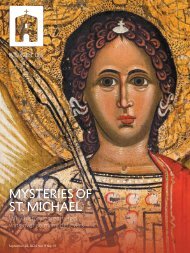Angelus News | December 20, 2019 | Vol. 4 No. 43
Pope Francis visits the Nativity scene in St. Peter’s Square after leading vespers on New Year’s Eve at the Vatican in 2016. This Advent, the pope took the unusual step of writing to Catholics about the importance of setting up and displaying a crèche or Nativity scene, not only at home but also in “the workplace, schools, hospitals, prisons, and town squares.” On Page 10, Mike Aquilina explains how its medieval, Franciscan roots illustrate why the crèche is much more than just a traditional Christmas decoration.
Pope Francis visits the Nativity scene in St. Peter’s Square after leading vespers on New Year’s Eve at the Vatican in 2016. This Advent, the pope took the unusual step of writing to Catholics about the importance of setting up and displaying a crèche or Nativity scene, not only at home but also in “the workplace, schools, hospitals, prisons, and town squares.” On Page 10, Mike Aquilina explains how its medieval, Franciscan roots illustrate why the crèche is much more than just a traditional Christmas decoration.
Create successful ePaper yourself
Turn your PDF publications into a flip-book with our unique Google optimized e-Paper software.
The case for the<br />
A new letter from Pope<br />
Francis argues that a<br />
Nativity scene is much more<br />
than a Christmas decoration<br />
crèche<br />
“The Adoration of the<br />
Child,” a 17th-century<br />
painting by Dutch artist<br />
Gerard van Honthorst.<br />
UFFIZI GALLERY/CATHOLIC NEWS SERVICE<br />
BY MIKE AQUILINA / ANGELUS<br />
It is indeed an age-old question: how to make worship<br />
relevant?<br />
The clergy struggled with it a thousand years ago, and<br />
especially at the great feast of Christmas. If Christians don’t<br />
understand the scriptural basis of the holiday, all they’re left<br />
with is revelry: tinsel and eggnog, to put it in modern terms.<br />
So in the 900s parishes began to develop tropes: short dramatic<br />
supplements to the liturgy. A scene would be set on or<br />
near the altar, and actors would play the parts in the Gospel<br />
story. Sometimes the tropes would be mimed while clergy<br />
proclaimed the seasonal readings. Other times they would<br />
be acted aloud.<br />
Over time, in some places, these efforts developed into<br />
grand productions, with musicians, dancers, and professional<br />
performers. The liturgy was eclipsed. The clergy got caught<br />
up in the showbiz spirit. And the play became the thing.<br />
In 1210, Pope Innocent III had had enough. He issued<br />
an edict forbidding the clergy from acting on stage, and<br />
commanded that the holy day performances be moved off<br />
church property.<br />
10 • ANGELUS • <strong>December</strong> <strong>20</strong>, <strong>20</strong>19


















